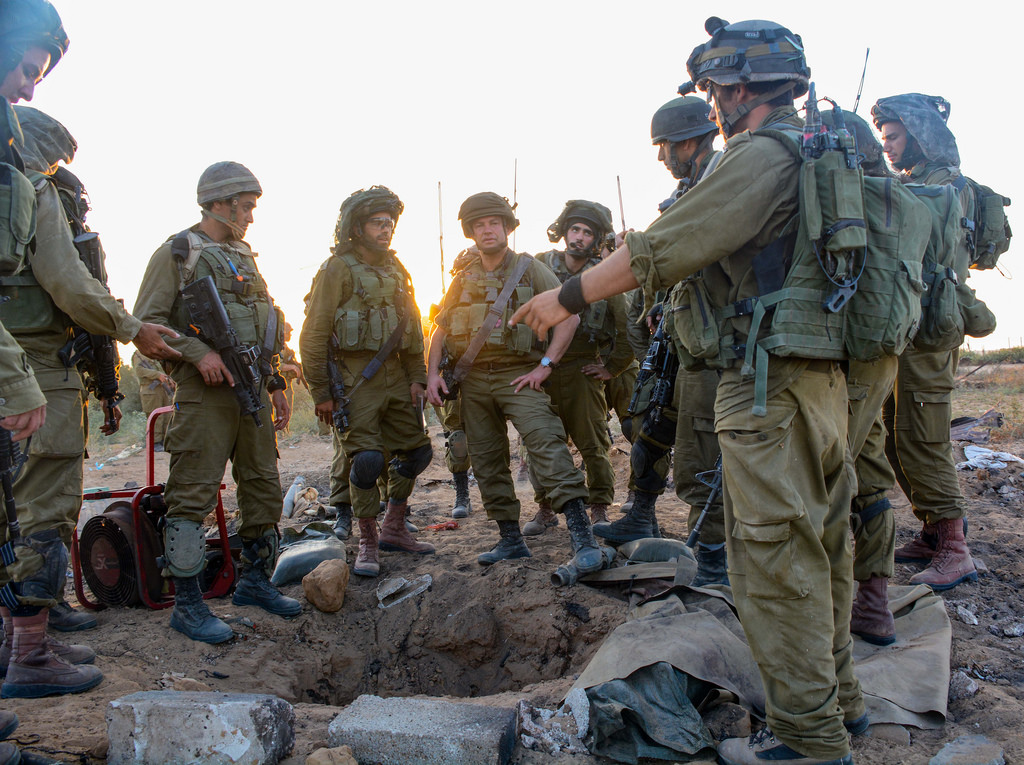Israel’s Military Advocate General Terminates ‘Black Friday’ and Other Investigations: Initial Observations
Since 2014, the IDF has been conducting investigations into incidents that took place in Gaza during Operation Protective Edge (July-August 2014) and raised concerns about Israeli Defense Forces (IDF) compliance with Israeli law and international law of armed conflict. In the course of the investigation, the office of the Military Advocate General (MAG)—Israel’s chief military legal officer—has reviewed some 360 incidents, referring 24 of them for criminal investigation. These have led so far to the conviction of three soldiers for the crime of looting.

Published by The Lawfare Institute
in Cooperation With

Since 2014, the IDF has been conducting investigations into incidents that took place in Gaza during Operation Protective Edge (July-August 2014) and raised concerns about Israeli Defense Forces (IDF) compliance with Israeli law and international law of armed conflict. In the course of the investigation, the office of the Military Advocate General (MAG)—Israel’s chief military legal officer—has reviewed some 360 incidents, referring 24 of them for criminal investigation. These have led so far to the conviction of three soldiers for the crime of looting. Additionally, 220 of the incidents were referred for examination by a high-level fact-finding team. On the basis of that team’s findings, the MAG decided to continue with criminal investigations of seven incidents. Of these, five did not result in criminal charges and two remain ongoing.
Throughout the process, the MAG has published periodic updates to explain his reasoning for closing or continuing certain investigations. A significant such update was published on August 18, 2018. “Update No. 6” explains the MAG’s decision to close its investigation into one of the deadliest and most controversial incidents of Operation Protective Edge—the fighting in and around the city of Rafah on Aug. 1, 2014. “Black Friday,” as the incident has been dubbed in the media, erupted during a humanitarian ceasefire following an ambush in which Hamas militants killed three IDF soldiers. The ambush provoked substantial Israeli response, which resulted in the deaths of more than 110 Palestinian civilians and militants.
close its investigation into one of the deadliest and most controversial incidents of Operation Protective Edge—the fighting in and around the city of Rafah on Aug. 1, 2014. “Black Friday,” as the incident has been dubbed in the media, erupted during a humanitarian ceasefire following an ambush in which Hamas militants killed three IDF soldiers. The ambush provoked substantial Israeli response, which resulted in the deaths of more than 110 Palestinian civilians and militants.
Half of the update focuses on fact-finding and explaining the MAG’s decision to close the criminal investigation into Black Friday. The rest of Update no. 6 is dedicated to explaining the MAG’s decision to close 15 other investigations, as well as details on the criminal trial that resulted in three looting convictions.
Below are some initial observations on the 30-page document. Much of the information relied upon by the MAG remains classified; hence its decisions can be assessed only on the basis of the evidence summarized within the public document. While the MAG reviewed the incidents from a predominantly criminal law perspective (i.e., whether the information on file suffices to bring criminal charges against IDF service members), in some cases, the advocate general recommended ‘command measures’ be taken against involved officers (e.g., reprimand, promotion freezing or dismissal). A portion of the Black Friday analysis was also dedicated to “lessons learned” from the incident that might guide future IDF operations.
Black Friday
On August 1, 2014, IDF soldiers from the Givati paratrooper unit were surveying an area for cross-border tunnels when they were ambushed by Hamas militants. At the time, the area was subject to a humanitarian ceasefire. In the initial exchange of fire, two IDF soldiers were killed. A third soldier, Lt. Hadar Goldin, was kidnapped and dragged inside a nearby tunnel dug by militants. It was subsequently discovered that Lt. Goldin was also killed in the ambush; his body is still being held by Hamas. At the time of the attack, however, IDF commanders believed Goldin was still alive, and the commanders took decisive actions to attempt a rescue. During the ensuing battle, at least 42 Palestinian militants and 72 civilians were killed.
The MAG was charged with investigating whether the fire power used in response to the ambush was proportional. A disproportionate response would have violated international laws of armed conflict as well as the IDF’s own operational directives.
Military Advantage and Proportionality
The MAG responded to allegations of disproportionate use of fire by IDF soldiers at a number of levels. Such allegations included claims that the IDF went on a rampage following the abduction of Lt. Goldin, massively and indiscriminately firing artillery, mortar and tank shells into densely populated Rafah, hitting scores of civilians and harming numerous civilian objects. Amnesty International, for example, alleged that Israel committed on Black Friday serious violations of international humanitarian law (IHL) which may amount to war crimes. Many of the actions taken in response to Lt. Goldin’s disappearance were pursuant to a pre-existing IDF operational directive for hostage recovery dubbed the “Hannibal Procedure.”
First, with regard to the casualty numbers, the MAG asserts that at least 42 Hamas militants were killed during the exchange of fire following the ambush, and that most of the 72 civilians were killed in airstrikes executed during active combat in the southeastern part of the town of Rafah. Although the report does not include an explicit statement to that effect, it appears as if the MAG concluded that the ratio of militant to civilian casualties does not suggest disproportionate harm.
Second, the MAG finds that not a single case of civilian death resulted from the use of direct fire by ground troops, and that artillery attacks and use of tank shells caused no more than 16 civilian deaths. This holding is a significant one. Many observers of Operation Protective Edge expressed great concern about the IDF’s use of inaccurate weapons such as artillery, mortars and tank shells in densely populated areas. According to the MAG, however, the use of such munitions was not the principal cause of civilian deaths in Black Friday. Furthermore, the MAG maintains that artillery was used only against specific targets, including strategic junctures designed to block Hamas reinforcements from arriving on the scene and open areas where possible exit hatches for the tunnel into which Lt. Goldin was taken could be found.
The MAG seems to attribute the relatively limited number of civilian casualties in the artillery phase of the operation to a conscious decision by IDF commanders not to use such weaponry around “sensitive targets,” where relatively large numbers of civilians could be anticipated. The document also notes that many residents of Rafah had already left the southeastern neighborhood in the weeks preceding Black Friday. They had done so following IDF warnings that major combat operations were expected in the area due to the presence of many cross-border tunnels, the destruction of which was the primary focus of Operation Protective Edge. This partial evacuation may be responsible for reducing harm to civilians that might otherwise have occurred given the IDF’s use of artillery shells on Black Friday.
Third, the MAG finds that, contrary to some claims made, the Hannibal Procedure—a controversial policy designed to allow rapid military response to abduction of IDF soldiers, and which has been understood by some IDF soldiers (erroneously, according to the MAG) as allowing aggressive action against kidnappers even at the expense of the life of the abducted soldier—did not play a role in the events that unfolded on Black Friday. The MAG maintains that the procedure does not purport to release the IDF from any obligation with respect to the principles of distinction and proportionality. Furthermore, it found no evidence supporting allegations that troops on the ground in and around southeastern Rafah understood the procedure as releasing them from their obligations under the law of armed conflict.
Fourth, in discussing the proportionality of firepower used by the IDF during ‘the incident, Update No. 6 presents an important analysis of the IDF’s military objective following the ambush, which offers insight into how commanders on the ground would have weighed anticipated harm to civilian lives and objects. According to the MAG, the proportionality analysis should not focus on determining whether the significant firepower used by the IDF was justified in order to prevent the abduction of one IDF soldier. Rather, it should focus on whether the use of force was justified in light of the specific combat missions of IDF forces that responded to the abduction. The ambush directed against the Givati patrol and subsequent abduction of Lt. Goldin were nothing but a "trigger" for the collapse of the humanitarian ceasefire and resumption of active hostilities. Thus, IDF forces entered en masse the area in which the ceasefire was violated and attacked legitimate targets in Rafah, including Hamas militants and other military and dual-use targets, such as access roads for potential enemy reinforcement. The MAG concluded that the firepower used in these attacks has to be assessed against the concrete military advantage expected in IDF combat operations against Hamas militants, as well as against the operational need to provide cover fire for the movement of troops in the theatre of hostilities. Following this proportionality analysis, the document goes on to discuss the application of the proportionality rule to specific IDF military action. With respect to each of the actions, the MAG finds that, in light of the IDF’s concrete military advantage and the limited anticipated civilian harm, no evidence of a violation of Israeli or international law.
We are of the view that the MAG’s mode of analysis is not problem-free. Although there is a certain logic to separating the "trees” (tactical objectives and specific military maneuvers) from the “forest” (strategic objectives of operations in Rafah)—especially when evaluating individual criminal responsibility—the update does not provide a clear answer to what we consider to be the main question of proportionality in bello raised by the circumstances of the case.
One can assume that the MAG is correct in observing that most of the harm to Palestinian civilians occurred during attacks undertaken in connection with concrete objectives of military operations, which resumed after Hamas violated the ceasefire, and not in connection with specific actions taken to recover Lt. Goldin. Yet the MAG admits that had the operation been conducted with more advance planning, rather than an emergency response to (what was believed to be) the abduction of Lt. Goldin, the safety of maneuvering forces could have been secured through means requiring less firepower, which would have likely entailed fewer civilian casualties.
We are concerned that the MAG failed to address the following legal questions, which should have been at the center of the discussion:
- How many uninvolved civilians were killed as a result of the need for quick action, which did not allow the responding IDF troops time for undertaking all possible precautions and required a high level of firepower to protect the troops? How many of these casualties could reasonably have been anticipated?
- Was the anticipated civilian harm excessive in relation to the need to save one soldier from being abducted or to protect the lives of IDF soldiers who quickly responded to the abduction?
We do not have clear answers to these questions, which admittedly raise a difficult doctrinal conundrum: at what level of operational abstraction should proportionality analysis be conducted in IHL and international criminal law—tactical, strategic or intermediary? Despite the lack of clarity in legal doctrine, we are of the view that such questions should have been considered by the MAG.
On Warnings, Intelligence and Criminal Proceedings
In explaining its decision to close investigations connected with Black Friday, as well as other incidents, the MAG cites "errors" in estimating the number of civilians inside targeted buildings as a cause of many civilian deaths. In one incident, for example, 35 civilians were killed in an airstrike on a building in which a senior Hamas commander was present. According to IDF intelligence, no civilians were likely to be inside the building at the time of the attack. In the unlikely event that there were any civilians present, their number was expected to be much lower than 35. In another case, nine civilians were killed during an overnight attack on a building identified as a Hamas facility. In fact, the building operated at night as a civilian coffee shop, which was not known to the IDF at the time. Furthermore, in a number of targeting cases in which some civilian presence was anticipated, the MAG took the view that the IDF did not have a legal obligation to provide early warning about the attack to the civilians. The MAG argued that such warnings would have undermined the purpose of the attacks, eliminating Hamas militants.
This assertion on precautionary measures raises difficult questions regarding the amount and quality of intelligence a military commander should gather prior to ordering an attack, particularly against buildings used by enemy combatants that might contain civilians. In the document, the MAG suggests that, at least in relation to criminal law, the burden on military commanders to gather substantial amounts of quality intelligence is low.
Importantly, the MAG does not find criminal fault with the IDF’s various intelligence failures—including those which resulted in considerable unanticipated harm to civilians. The document also explicitly notes the absence of legal obligation to provide early warning to civilians in advance of a military action when such a warning warning would frustrate the purpose of the action [First Additional Protocol, art. 57(2)(c)]. We fear that this approach will lead the exception to the rule—no advanced warning in extreme circumstances—to become the norm, and that attacks will be sanctioned even when it is apparent that the IDF acts with partial or unconfirmed information on the number of civilians located inside targeted buildings. Granted, this last observation is subject to selection bias, since only cases involving collateral damage were brought to the attention of the MAG for further investigation. We have no information on the number of incidents during Protective Edge in which attacks were suspended or cancelled because of the availability of accurate information on the presence of civilians in the vicinity of the military target.
For the purposes of attributing criminal responsibility to individual soldiers, the MAG's position may be reasonable. It should be noted, however, that individual criminal responsibility is not the only standard that the MAG should uphold under Israeli and international law. The laws of armed conflict deal primarily with the obligation of states. In our view, the document does not adequately explain whether Israel adequately fulfilled its obligations to the civilian population of Gaza regarding the collection of intelligence and warnings prior to attacks.
Furthermore, the approach taken in Update No. 6 stands in sharp contrast to the more stringent approach taken in a 2011 report by a governmental investigative committee headed by Israeli Supreme Court Justice Tova Strasberg-Cohen. That investigation examined the performance of security services in the targeted killing of Salah Shehadeh in July 2002—an attack that resulted in the deaths of 13 civilians. In that report, it was determined that the process of gathering intelligence prior to the attack was flawed.
The Fact-Finding Examination Mechanism
Finally, it should be noted that the fact-finding mechanism on whose reports the MAG relied carried out a very thorough examination (although we are not in a position to endorse press reports that describe the effort as equivalent to a “doctoral thesis”). Such a comprehensive examination of the facts is indeed required under international law. However, an in-depth analysis of a battle in which thousands of soldiers participated, and many thousands of artillery shells, missiles and bullets were fired, takes time (especially since investigatory cooperation by the Palestinian side was extremely limited). More than four years have passed since the incident, and this lengthy period of time does not appear to satisfy international legal requirements, as Israel’s own Turkel Commission had identified, for prompt investigations following allegations of serious violations of international humanitarian law or human rights law.
In our view, when the Turkel Commission recommended the creation of a fact-finding mechanism in 2013, such a mechanism was intended for quick assessments of preliminary factual examination. This would serve as a prompt filtering device for the military advocate general, obviating the need to open military police investigations in situations that do not warrant criminal investigations. In actuality, the fact-finding mechanism has been comprehensive and detailed in its endeavors. This has left the fact-finding process subject to delays and lengthy deliberations.
This departure from the mechanism’s intended purpose necessitates some questions: Does the MAG’s fact-finding investigations (or preliminary examinations), conducted without the tools possessed by criminal investigators, actually allow the MAG to ascertain the truth or lay the groundwork for criminal prosecution in appropriate cases? What was the reason underlying the MAG’s decision to mandate the carrying out of an in-depth examination by a military-professional body and not by the military police? Was it the fear of labeling the examination as a criminal investigation, which could have evoked a negative reaction by Israeli public opinion? And, most significantly, does the length of examination effectively preclude the possibility of opening a criminal investigation should it be warranted, given the limited value of court testimony delivered more than four years after the events took place?



.jpg?sfvrsn=5a43131e_9)


